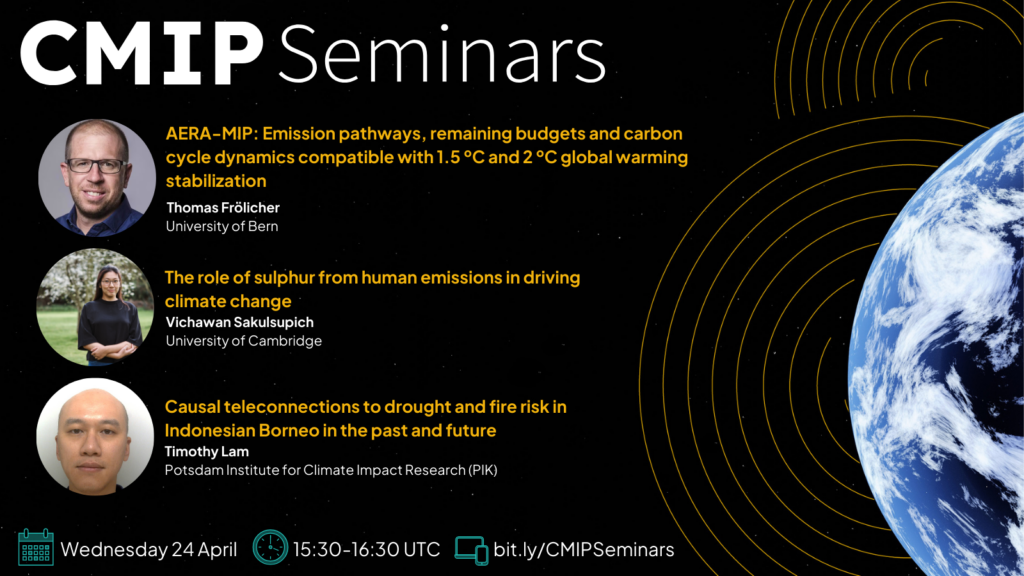
24 April, 2024 @ 15:30 – 16:30 UTC
First session of the CMIP Seminar Series.
Jump to:

Registration
Click the button below to register. We’ll send out information on how to attend the seminars to this list a few hours before the event starts. Note that, if you registered for a previous event, you are already registered for all future events.
Speakers

Thomas Frölicher Professor, University of Bern
Title: AERA-MIP: Emission pathways, remaining budgets and carbon cycle dynamics compatible with 1.5 ºC and 2 ºC global warming stabilization
Abstract: While international climate policies now focus on limiting global warming well below 2 °C, or pursuing 1.5 °C, the climate modeling community has not provided an experimental design in which all Earth System Models (ESMs) converge and stabilize at the same prescribed global warming levels. This gap hampers accurate estimations based on comprehensive ESMs of the carbon emission pathways needed to meet such agreed warming levels, and of the associated climate impacts under temperature stabilization. Here, we apply the Adaptive Emission Reduction Approach (AERA) with ESMs to provide such simulations in which all models converge at 1.5 °C and 2.0 °C warming levels by iteratively adjusting their emissions. These emission-driven simulations provide a wide range of emission pathways and resulting atmospheric CO2 projections for a given warming level, uncovering uncertainty ranges that were previously missing in the traditional CMIP scenarios with prescribed greenhouse gas concentration pathways. Meeting the 1.5°C warming level necessitates a 40 % (model full range: 7 to 76 %) reduction in multi-model mean CO2-forcing equivalent (CO2-fe) emissions from 2025 to 2030, a 98 % (57 to 127 %) reduction from 2025 to 2050, and a stabilization at 1.0 (-1.7 to 2.9) PgC yr-1 from 2100 onward after the 1.5 °C target is reached. The on-average positive emissions under stabilized global temperatures are consistent with a slightly negative zero emissions commitment – initially assumed zero – and lead to an increase in the post-2025 CO2-fe emission budget by a factor 2.2 (-0.8 to 6.9) by 2150 for the 1.5 °C warming level and a factor 1.4 (0.9 to 2.4) for the 2.0 °C warming level compared to its first estimate in 2025. Overall, this new type of target-based emission-driven simulation offers a more coherent assessment across climate models and opens up a wide range of possibilities for studying both the carbon cycle and climate impacts under climate stabilization.

Vichawan Sakulsupich PhD Student, University of Cambridge
Title: The role of sulphur from human emissions in driving climate change
Abstract: To inform climate policy decisions, precise Earth system models are essential. These models, comprising various components like the atmosphere and ocean, enable a quantitative analysis of climate system interactions, crucial for understanding climate change drivers and responses. Aerosol modelling within these systems poses a significant challenge due to their complex chemical reactions and interaction with clouds, contributing to uncertainties in energy budget calculations. This study examines how aerosols influence climate amidst changing human emissions, as these emissions alter atmospheric constituents, impacting aerosol production and subsequently climate dynamics.
The relationship between anthropogenic emissions and radiative forcing presents a persistent challenge in climate science. Emissions, atmospheric chemistry, and climate intricately intertwine through the formation of secondary aerosols like sulfate, nitrate, and organic aerosols. Sulfur dioxide (SO2), a key aerosol precursor primarily from human activities, undergoes rapid conversion to sulfate through oxidation. Unlike greenhouse gases, anthropogenic aerosols exhibit heterogeneous distribution due to localized emissions and short atmospheric lifetimes. Thus, understanding SO2 conversion to aerosol is vital, reflecting emission locations and changing oxidant availability.
Utilizing CMIP6 archived data and UKESM1 data, this research investigates sulfate aerosol and cloud properties’ modelled responses to emission increases and oxidant variations from 1850 to 2014. Analysis of CMIP6 and AerChemMIP experiments reveals significant shifts in SO2 atmospheric oxidation processes over this period, impacting calculated radiative forcing. Ultimately, this study enhances process-level comprehension within Earth system models, focusing on interactive aerosol simulation from precursors, to refine aerosol radiative forcing predictions.
Website: https://vichawans.github.io/

Timothy Lam Postdoctoral researcher, Potsdam Institute for Climate Impact Research (PIK)
Title: Causal teleconnections to drought and fire risk in Indonesian Borneo in the past and future
Abstract: Fires occurring over the peatlands in Indonesian Borneo accompanied by droughts have posed devastating impacts on human health, livelihoods, economy and the natural environment, and their prevention requires comprehensive understanding of climate‐associated risk. Although it is widely known that the droughts are associated with El Niño events, the onset process of El Niño and thus the drought precursors and their possible changes under the future climate are not clearly understood. Here, we use a causal network approach to quantify the strength of teleconnections to droughts at a seasonal timescale shown in observations and climate models. We portray two drivers of JJA droughts identified through literature review and causal analysis, namely Niño 3.4 SST in JJA and SST anomaly over the eastern North Pacific to the east of the Hawaiian Islands (abbreviated as Pacific SST) in MAM. We argue that the droughts are strongly linked to ENSO variability, with drier years corresponding to El Niño conditions. The droughts can be predicted with a lead time of 3 months based on their associations with Pacific SST, with higher SST preceding drier conditions. We find that under the SSP585 scenario, the CMIP6 multi-model ensembles show significant increase in both the maximum number of consecutive dry days in the Indonesian Borneo region in JJA (p = 0.006) and its linear association with Pacific SST in MAM (p = 0.001) from year 2061 to 2100 compared with the historical baseline. Some models are showing unrealistic amounts of JJA rainfall and underestimate drought risks in Indonesian Borneo and their teleconnections, owing to the underestimation of ENSO amplitude and overestimation of local convections. Our study strengthens the possibility of early warning triggers of fires and stresses the need for taking enhanced climate risk into consideration when formulating long‐term policies to eliminate fires.
Interested in speaking at a future seminar? Let us know by clicking the button below.
